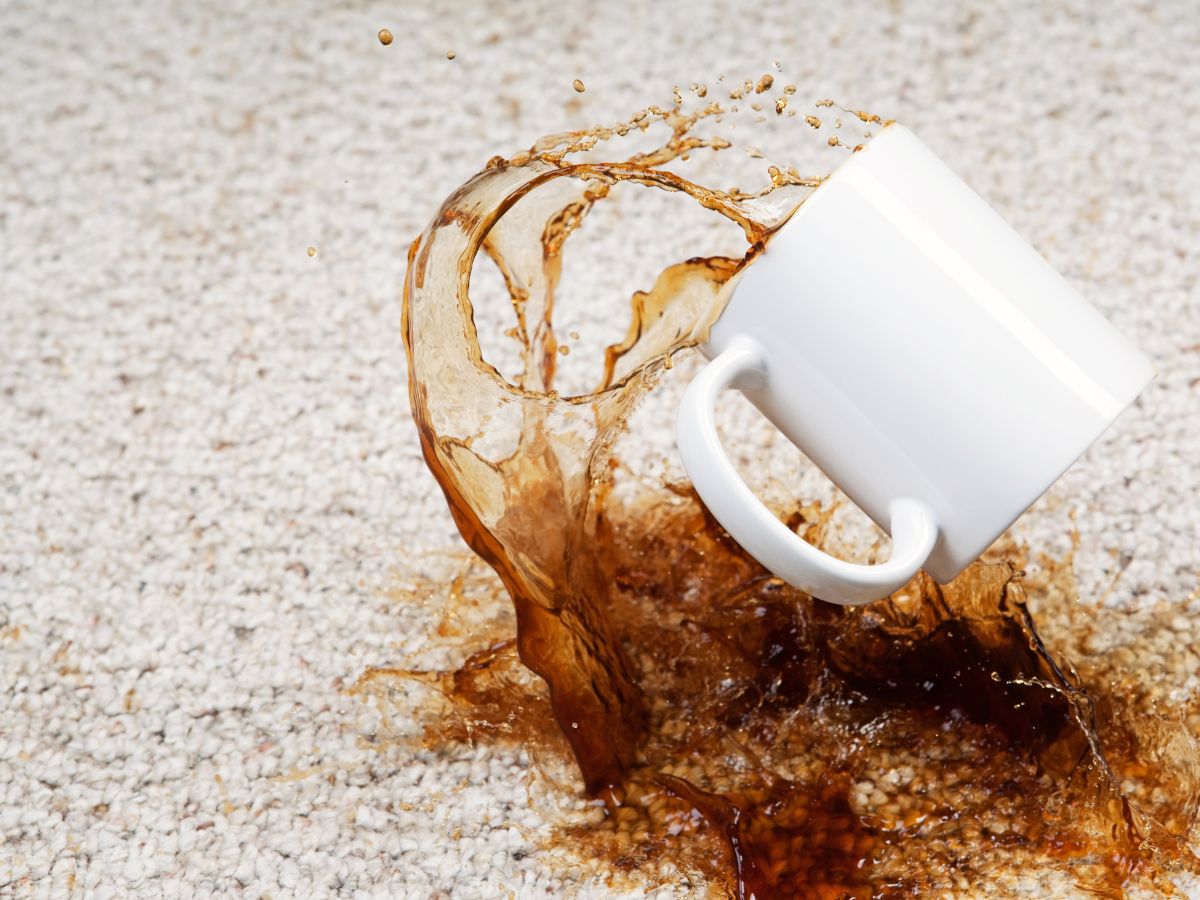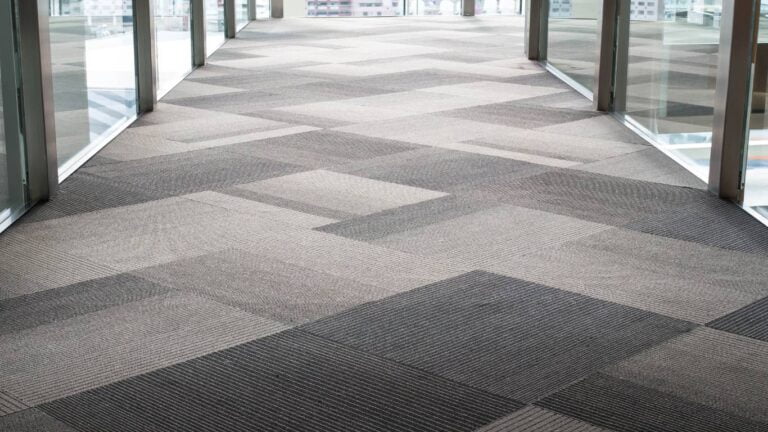Figuring out how to get coffee stains out of carpet, couches or clothing can be the saving grace after an unfortunate spill. Coffee stains are a common nuisance, but with the right approach, you can tackle them effectively. This guide will offer a comprehensive overview of methods ranging from DIY solutions to professional services, each designed to combat those stubborn brown blemishes.

Immediate Response to Coffee Spills
When you’re faced with the all-too-common mishap of a coffee spill on your carpet, acting quickly is key. Coffee is notorious for leaving stubborn stains, so tackling the spill right away will help stop the liquid from seeping deeply into the carpet fibres.
Blotting the Stain Correctly
Your first move in handling a coffee spill is to soak up the excess liquid. It’s best to use a white cloth or paper towel for this task to avoid any colour transfer. By gently dabbing the stained area, you’ll absorb the coffee. Remember, it’s important not to rub as this can make matters worse by spreading the stain or pushing it deeper into the carpet.
Preventing the Stain from Setting
To keep the coffee from setting into the carpet, a bit of cold water can be useful. Pour a small amount onto the stain to help dilute the coffee. Then, continue to blot with a clean section of the cloth. You might have to repeat this process several times until the cloth doesn’t pick up any more coffee.
Using Plain Water for Initial Cleaning
Often, plain water is all you need for an initial clean. It’s a safe and handy option for most carpet types. If the stain persists after diluting and blotting with water, you’ll probably need to turn to a stronger cleaning solution.
Handling Different Carpet Types
Carpets vary and may require specific care when dealing with coffee stains. For instance, a plush carpet might hold onto more liquid than a low-pile one, needing extra blotting and possibly a gentle brushing to lift the fibres. Always take into account your carpet’s material before using any cleaning agents, as some fabrics might not take kindly to certain chemicals. For more information on carpet types, visit our article on different types of carpet.
If the coffee has dried or the spill is in a high-traffic area, you’ll need a more comprehensive approach. Warm water can help loosen a set-in stain. Be sure to work from the stain’s outer edge towards the centre to avoid spreading it.
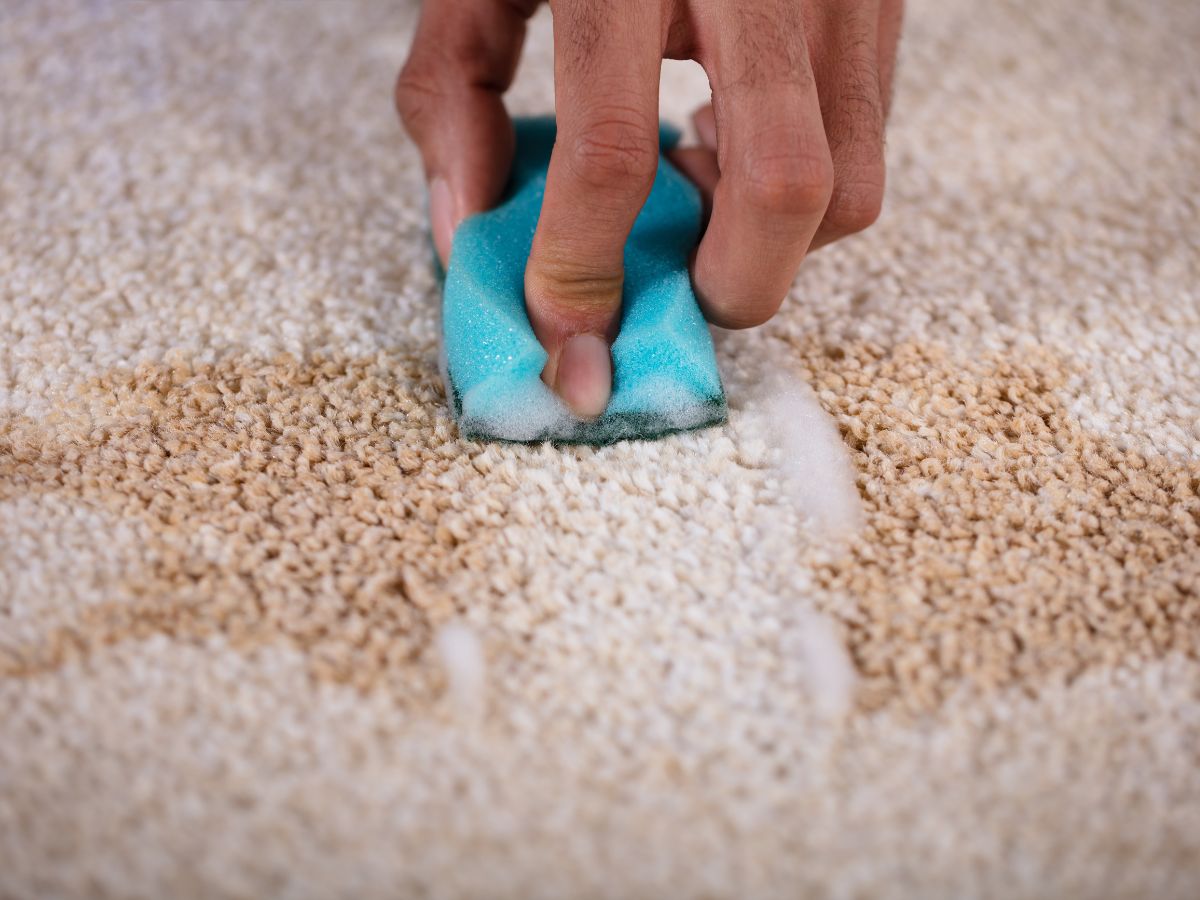
DIY Stain Removal Solutions
Vinegar and Detergent Method
For a natural way to address coffee stains, a mix of vinegar and detergent can be quite effective. Follow the instructions below:
- Remove excess: Soak up the excess liquid using the blotting technique previously explained.
- Mix the solution: Combine 2 cups of warm water, 1 tablespoon of white vinegar, and ½ – 1 teaspoon of mild dish soap in a bowl.
- Apply the solution: Use a sponge or cloth to apply the solution to the stain, taking care not to soak the carpet.
- Blot the stain: Gently blot the area with a clean, dry cloth to lift the stain.
- Rinse and dry: Rinse the area with a small amount of water and blot dry to remove any soapy residue.
Baking Soda Method
Baking soda is known for its cleaning power, especially on stains. Follow these steps to use baking soda for coffee stains:
- Make a paste: Combine three parts water to one part baking soda.
- Apply the paste: Apply the paste to the coffee stain.
- Let it dry: Allow the paste to dry completely, which might take about 20 minutes.
- Vacuum the residue: Vacuum up the dried residue.
- Repeat if necessary: If the stain remains, repeat the process to fully remove it.
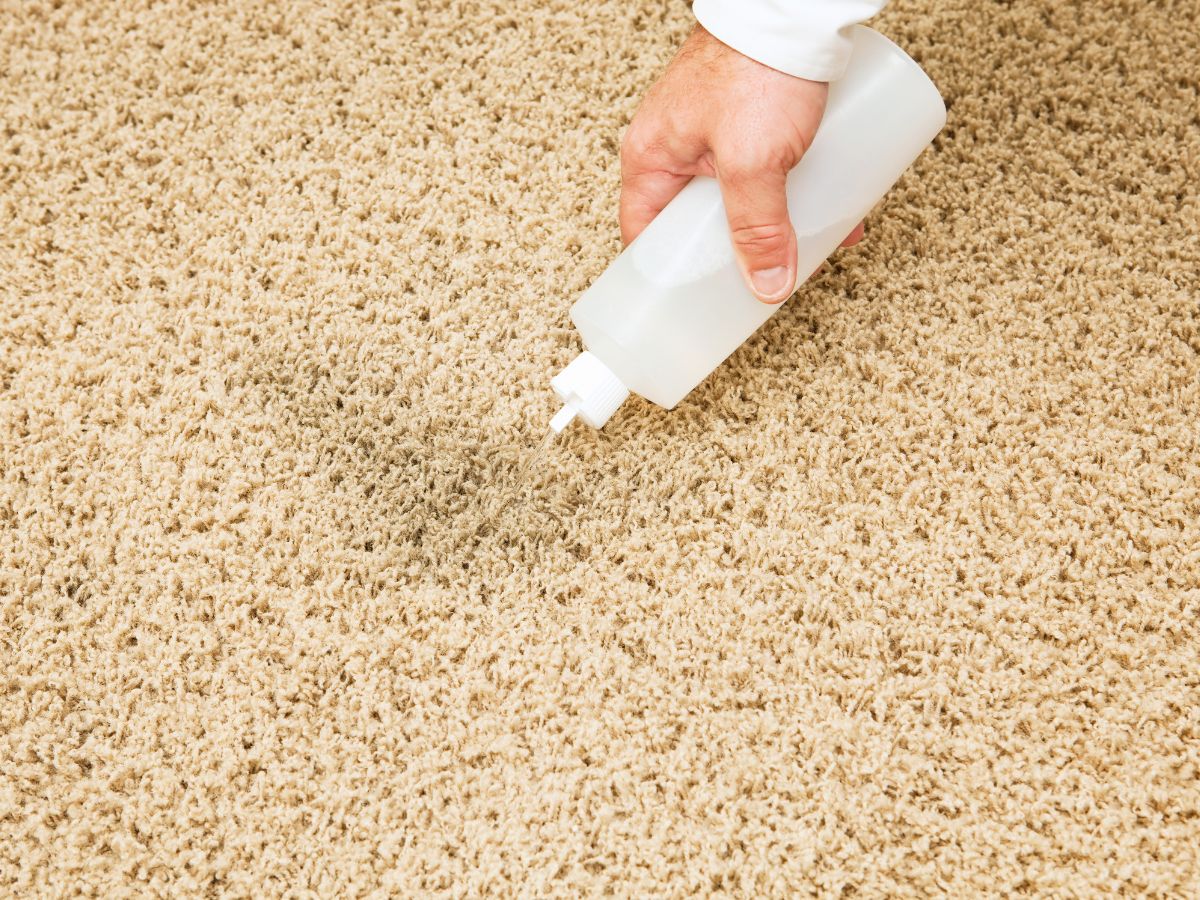
Using Hydrogen Peroxide
Hydrogen peroxide is a versatile cleaner that can tackle even tough stains. But be extremely careful because it may bleach or discolour carpet, especially if it’s a higher concentration than 3%, which is the most common household strength. Follow these steps to use hydrogen peroxide:
- Mix the solution: Combine 2 parts of hydrogen peroxide with 1 part of dish soap.
- Test the solution: Test this mixture on a hidden part of your carpet to ensure it’s safe.
- Apply the solution: Once safe, apply the mixture to the stain.
- Let it sit: Allow the mixture to sit for at least 10 minutes.
- Rinse and dry: Rinse the area with a cloth dampened with water and blot it dry.
- Air-dry completely: Let the carpet air-dry completely and then vacuum to fluff up the fibres.
Commercial Carpet Cleaners
Commercial carpet cleaners offer a durable option for tackling coffee spills. These machines vary in size and power, with some designed for spot treatments and others for larger-scale tasks. Owning one allows for immediate action against spills, reducing the dependence on professional cleaning services or rented equipment.
The selection of a carpet cleaner should be tailored to the frequency of use and the dimensions of the space you intend to clean. For example, a model with a large capacity tank and various attachments would be ideal for extensive areas or if you need to clean upholstery.
Choosing the Right Carpet Cleaner
It’s important to choose a carpet cleaner that aligns with your specific requirements. For homes prone to frequent spills or with expansive carpeted spaces, a model with a significant holding tank and multiple attachments for different surfaces is advantageous.
Conversely, a smaller, more manoeuvrable machine may be more appropriate for less frequent, smaller-scale tasks. When selecting a cleaner, consider its capacity, features, and whether it is suitable for your carpet type.
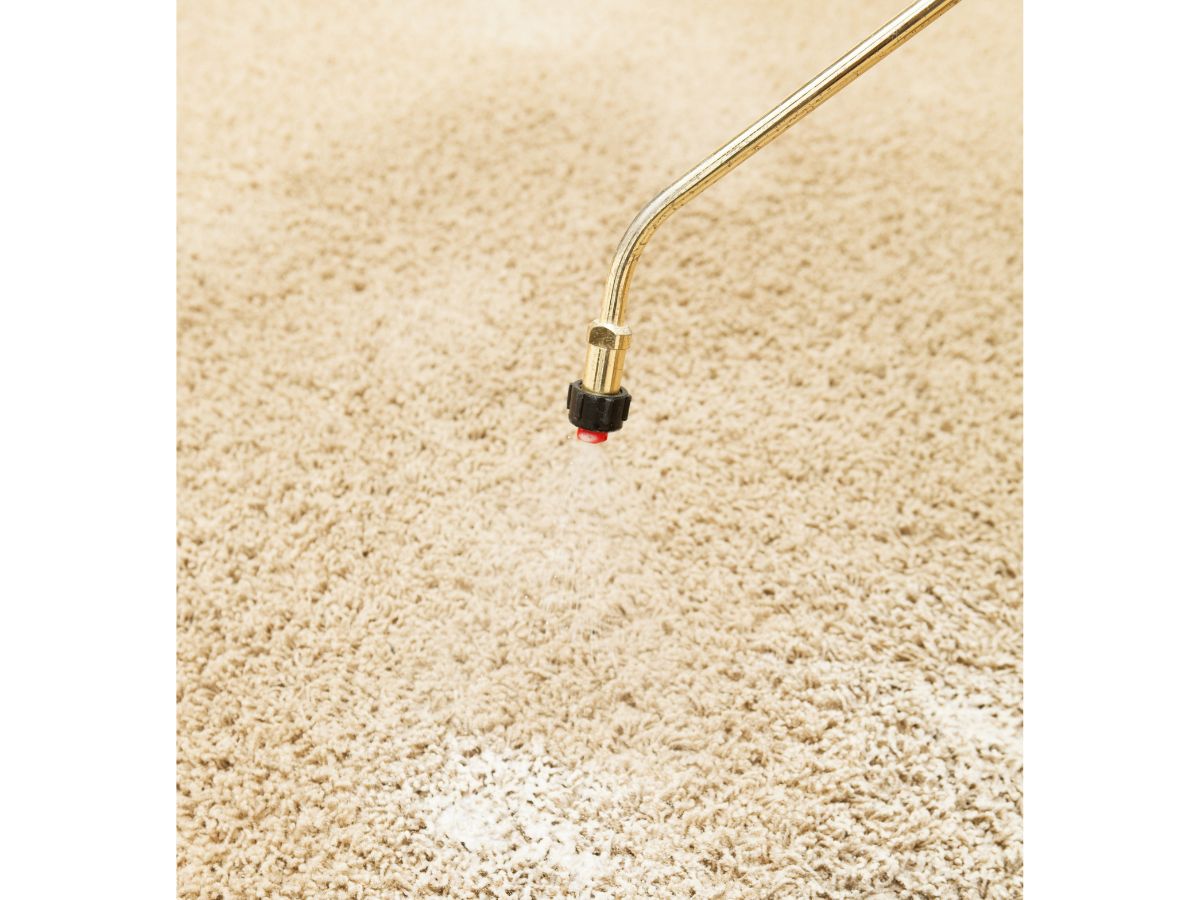
Application Techniques for Best Results
To achieve optimal results, adhere to the guidelines provided by the carpet cleaner manufacturer. This includes the recommended mixture of cleaning solutions and the prescribed method of application. Excessive moisture can cause problems such as colour bleeding, fibre damage, and the growth of mould and mildew.
Employing a wet vacuum to remove as much moisture as possible post-cleaning is recommended. Proper use of water and cleaning agents, coupled with effective moisture extraction, will aid in preserving the carpet’s condition and aesthetic.
Spot Testing Chemical Cleaners
Conducting a spot test on a concealed section of your carpet is critical before using any chemical cleaner on a visible area. This precautionary measure helps to avoid unexpected reactions that could lead to fading or additional staining.
To perform a spot test:
- Apply a small quantity of the cleaning solution to a discrete area.
- Wait for the suggested duration.
- Remove the solution as instructed, typically by blotting or vacuuming.
- Inspect the test area under adequate lighting to confirm there’s no discoloration or damage.
If the test reveals any negative effects, consider an alternative cleaning agent or consult a carpet cleaning professional.
Safety Precautions with Chemicals
When handling chemical cleaners, it’s essential to take safety measures to safeguard yourself and your surroundings. Ensure good air circulation to prevent the accumulation of harmful fumes. Utilise protective equipment such as masks and gloves, and keep the area well-aired by opening windows and doors.
Moreover, store chemical cleaners away from any sources of ignition due to the flammability of some substances. In addition to gloves, wear goggles to protect against skin and eye irritation. Carefully read and follow the product’s instructions and keep the cleaning area inaccessible to children and pets during the process.
Stubborn Stain Removal Techniques
When a dried coffee stain presents a challenge, patience and the correct techniques are essential. If the coffee spill included cream or sugar, an enzyme laundry detergent with warm water can be particularly effective in breaking down these substances.
Revisiting the Stain Post-Cleaning
Should remnants of the stain linger after the carpet has dried, a second cleaning may be necessary. Ensure the spot is completely dry before attempting further cleaning to protect the carpet fibres.
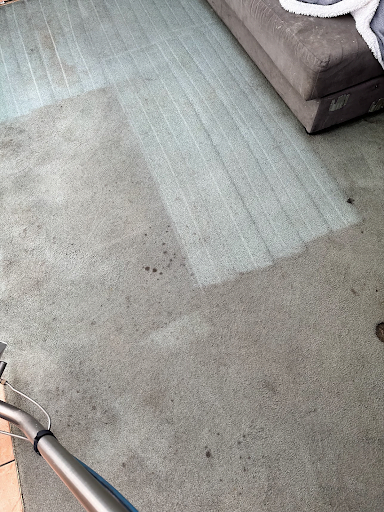
Using Steam Cleaning
Steam cleaning can be an effective method for eliminating persistent coffee stains. The heat and moisture from a steam cleaner can dissolve and lift away the dried coffee residue. The high-pressure jets of a steam cleaner are adept at reaching deep into the carpet fibres, breaking down tough stains without leaving behind any residue. Steam cleaning also sanitises the carpet, eliminating bacteria and germs.
Professional Cleaning Services
For stains that resist home treatments, professional carpet cleaners can offer their expertise and advanced equipment. These specialists have access to industrial-strength steam cleaners and carpet shampoos that are formulated to address the most stubborn stains. Opting for a professional service ensures that your carpet receives the most effective care.
Carpet Care Post-Stain Removal
Drying the Carpet Thoroughly
After addressing a stain, ensure the carpet is completely dry to prevent mould and maintain the integrity of the fibres. An effective technique is to cover the damp area with a layer of absorbent cloth or paper towels and place a weight on top. This method helps wick away the moisture. Change the clothes or towels until no more water is absorbed.
For situations where the padding is wet, a more thorough approach is necessary. Begin by carefully lifting a corner of the carpet. Promote drying by directing airflow between the carpet and padding, using fans or a vacuum cleaner set to blow air. In enclosed spaces, a dehumidifier can assist in removing humidity. If residual dampness persists, lay down towels and tread on them to soak up the water, repeating with dry towels as needed.
Ensure the subfloor and padding are also moisture-free to prevent any further complications.
Fluffing Carpet Fibres Back to Life
After drying, the fibres may appear compressed. To restore the carpet’s plushness, gently tease the fibres with your fingers or a soft-bristled brush. This action rejuvenates the carpet’s appearance and helps avert the fibres from matting down permanently.
When to Consider Carpet Replacement
Eventually, carpets may reach a point where replacement is the best option. Indicators of a carpet’s decline include persistent allergies, noticeable wear such as matting, colour loss, or diminished padding. If the carpet shows buckling or wrinkling, re-stretching is an option, though it may be an expensive one.
Weighing the cost of repairs against the value of a new carpet is important. A carpet specialist can provide guidance on whether to repair or replace your carpet.
A Fresh Start for Your Carpet
Coffee spills on your carpet no longer have to be a cause for despair. By using natural and readily available household remedies, you can tackle the problem efficiently and keep your carpet looking its best. Remember, swift action coupled with the right techniques makes all the difference. Whether you choose to mix a homemade cleaner, utilise commercial options, or call in the professionals, you have a full arsenal at your disposal to combat those pesky stains.

